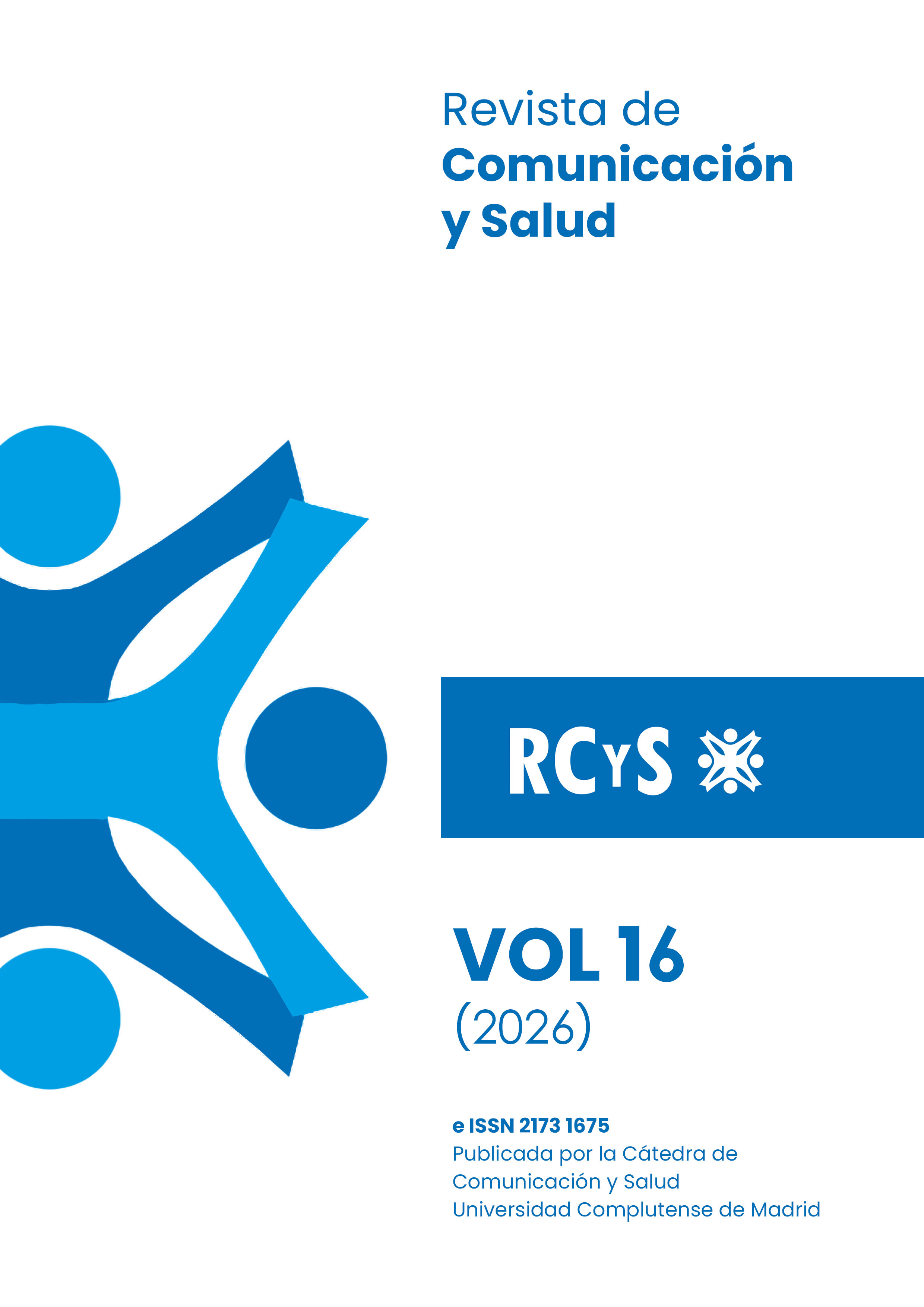Animated narratives in health education: The potential of animated film in patient and caregiver training
DOI:
https://doi.org/10.35669/rcys.2026.16.e384Keywords:
Health Literacy, Animated movies, Communication, Rare diseases, Alzheimer disease, Wrinkles, The Secret of AmilaAbstract
Introduction: The study proposes the use of animated film as a potentially effective tool in the field of health communication and education. Through two films— Wrinkles (2011) and The Secret of Amila (2015)—this medium is highlighted to improve the understanding of complex medical concepts, reduce stress, and foster treatment adherence. Methodology: The research adopts a qualitative approach, considering narrative, visual, and symbolic elements. An interpretative textual analysis is carried out, assessing dramatic structure, character development, and aesthetic resources. The literature review supports the selection of the films, combining studies on health education, health literacy, and the use of cinema in educational contexts. Results: Both films present qualities that support the aims of the study, conveying complex medical processes through human and emotional perspectives. Discussion: The ability of animated narratives to express subjective and cultural clinical experiences is valued as a useful instrument for raising social awareness and for educational training. Conclusions: Animation emerges as a potentially suitable medium to promote health literacy, humanize the experience of illness, and foster empathetic attitudes among diverse audiences.
Downloads
References
Astudillo Alarcón, W. y Mendinueta Aguirre, C. (2008). El cine como instrumento para una mejor comprensión humana. Revista de Medicina y Cine, 4(3), 131-136. https://revistas.usal.es/cinco/index.php/medicina_y_cine/article/view/16546
Durán, J. (2016). El cine de animación estadounidense. Editorial UOC.
Federación Española de Enfermedades Raras. (2018). Asume un reto poco frecuente: Proyecto de sensibilización para la educación secundaria. Memoria curso escolar 2017-2018. FEDER y SANOFI GENZYME. https://www.enfermedades-raras.org/sites/default/files/documentos/Memoria_asume_reto_%202017-2018.pdf
Ferreras, I. (2011). Arrugas [película]. Perro Verde Films, Cromosoma TV produccions.
García-Martínez, J. y Moreno-Mora, D. (2021). El trabajo con películas en psicoterapia. Recursos Audiovisuales en Psicoterapia, 22(86/87), 5-20. https://doi.org/10.33898/rdp. V22i86/87 DOI: https://doi.org/10.33898/rdp.v22i86/87.622
van Goidsenhoven, L. y Masschelein, A. (2021). “Writing by prescription”: Creative writing as therapy and personal development. En A. Masschelein y D. de Geest (Eds.), Writing manuals for the masses (pp. 215-236). https://doi.org/10.1007/978-3-030-53614-5_11 DOI: https://doi.org/10.1007/978-3-030-53614-5_11
González de Dios, J. (2010). Cine y Pediatría (I): Una oportunidad para la docencia y la humanización en nuestra práctica clínica. Revista Pediatría de Atención Primaria, 12(46), 299-313. https://pap.es/articulo/11246/cine-y-pediatria-i-una-oportunidad-para-la-docencia-y-la-humanizacion-en-nuestra-practica-clinica DOI: https://doi.org/10.4321/S1139-76322010000300014
Guarinos Galán, V. (Coord.). (2023). El envejecimiento en las series de ficción. Tirant Editorial. https://editorial.tirant.com/es/ebook/el-envejecimiento-en-las-series-de-ficcion-virginia-guarinos-galan-9788419632197
Hansen, S., Jensen, T., Schmidt, A., Strøm, J., Vistisen, P. y Høybye, M. (2024). The effectiveness of video animations as a tool to improve health information recall for patients: Systematic Review. Journal of Medical Internet Research, 26, 1-10.
https://doi.org/10.2196/58306 DOI: https://doi.org/10.2196/58306
Lavado Landeo, L. (2020). Uso del cine como herramienta en el proceso de enseñanza-aprendizaje en los doctorados de medicina y ciencias de la salud. Horizonte Médico (Lima), 20(3), E1306. https://doi.org/10.24265/horizmed.2020.v20n3.09 DOI: https://doi.org/10.24265/horizmed.2020.v20n3.09
Martín García, T., Marcos Ramos, M. y González de Garay, B. (2022). Representación de la vejez en el cine español: un estudio de personajes mayores de 65 años en películas contemporáneas. Varia, 26(113), 357-372. https://doi.org/10.26807/rp. v27i113.1862 DOI: https://doi.org/10.26807/rp.v27i113.1862
Martínez Riera, J. R. (2017). Las personas mayores a través del cine. Gerokomos, 28(2), 56-62. https://scielo.isciii.es/scielo.php?script=sci_arttext&pid=S1134-928X2017000200056&lng=es&tlng=es
Moe-Byrne T., Evans E., Benhebil N. y Knapp P. (2022) The effectiveness of video animations as information tools for patients and the general public: A systematic review. Front. Digit. Health, 4. https://doi.org/10.3389/fdgth.2022.1010779 DOI: https://doi.org/10.3389/fdgth.2022.1010779
Ministerio de Educación, Ciencia y Tecnología (2004). El cine de animación. Consejo Federal de Educación. http://www.bnm.me.gov.ar/giga1/documentos/EL001378.pdf
Morales Pillado, C., García Tabuyo, M., Álvarez Ortiz, C., Gervás Sanz, M., Pardo Cebrián, R., Pérez Cabrero, Ó., de la Torre Martí, M. y Santacreu Ivars, M. (2015). Guía de intervención clínica infantil. Centro de Psicología Aplicada (CPA). Universidad Autónoma de Madrid (UAM). https://www.uam.es/uam/media/doc/1606899110986/guia-infantil.pdf
Muñoz Ruiz, D. (2017). Cine, niños y educación: el niño como espectador cinematográfico [Tesis doctoral]. Universidad Complutense de Madrid. https://hdl.handle.net/20.500.14352/22050
Pagès-Puigdemont, N. y Valverde-Merino, M. I. (2018). Adherencia terapéutica: factores modificadores y estrategias de mejora. Ars Pharmaceutica, 59(4), 251-258. https://doi.org/10.30827/ars.v59i4.7357 DOI: https://doi.org/10.30827/ars.v59i4.7357
Ramos de Andrade, M. F. y Moço Aparicio, A. S. (2019). Escrituras contemporáneas: el cine de animación. Praxis & Saber, 10(22), 221-246. https://doi.org/10.19053/22160159.v10.n22.2019.7647 DOI: https://doi.org/10.19053/22160159.v10.n22.2019.7647
Riffo, I. y Dittus, R. (2019). Imaginación y cine: la noción de anthropos desde la figura del espectador. Comuni@cción: Revista de Investigación en Comunicación y Desarrollo, 10(2), 122-130. https://doi.org/10.33595/2226-1478.10.2.384 DOI: https://doi.org/10.33595/2226-1478.10.2.384
Sánchez-Navarro, J. (2020). La imaginación tangible: Una historia esencial del cine de animación. Editorial UOC. https://www.casadellibro.com/libro-la-imaginacion-tangible-una-historia-esencial-del-cine-de-animac-ion/9788491807025/11459727?srsltid=AfmBOoozA8jsfx7S3OKIuZrCTJIMTWkb7pL86gHevWsedogXnZMV4yIr
Servicio de Información sobre Discapacidad (29 de septiembre de 2015). La película ‘El secreto de Amila’ acerca la realidad de los niños con Enfermedades Raras. https://sid-inico.usal.es/noticias/la-pelicula-el-secreto-de-amila-acerca-la-realidad-de-los-ninos-con-enfermedades-raras/
Vázquez, G. (2015). El secreto de Amila [Película]. Baleuko, Draftoon Animation, Talape.
Downloads
Published
How to Cite
Issue
Section
License
Copyright (c) 2025 Aramis Guerrero Muñoz (Autor de Correspondencia)

This work is licensed under a Creative Commons Attribution-NonCommercial 4.0 International License.
Disclaimer: As of 2023, RCyS is licensed under the Creative Commons Attribution-NonCommercial 4.0 International License (CC BY-NC 4.0).
Articles from 2011 to 2022 are under a Creative Commons CC BY 4.0 License that allows copying and redistributing the material in any medium or format, remixing, transforming and building upon the material for any purpose, including commercial.
We also inform that RCyS is adhered to the Declaration of Berlin.






